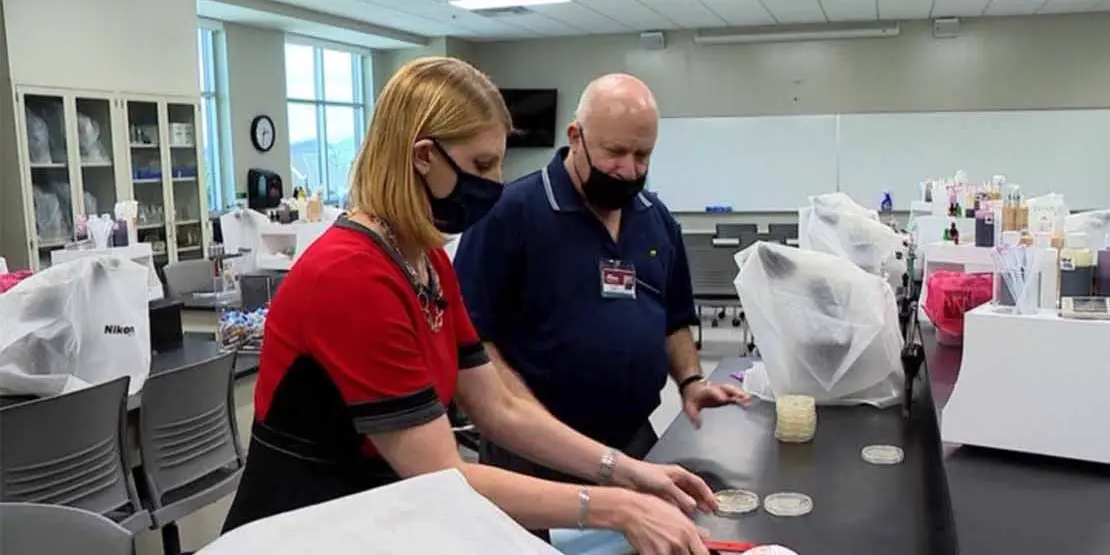Posted on the WLOS-13 website on July 6, 2020.
Asheville, N.C. (WLOS) — If the state's trends continue, local public health officials say COVID-19 cases could potentially overwhelm the state's hospitals later in July. The mandate to wear a mask in public spaces is in place to help slow the spread. But how well do they protect you? News 13 took several masks to the lab to find out. The CDC calls masks “source control.” News 13 tested three types, paper, cloth, and an N95, to see how well the masks protect against the spread of respiratory droplets, which can contain bacteria and the coronavirus.
State's Mask Mandate Caused A Strong Reaction
A grandmother and an 8-year-old were targeted with pepper spray outside a Haywood County Dollar General on June 29 for not wearing masks. Investigators are looking for a suspect. Witnesses at the scene stated the van had a Virginia license plate and turned left from the parking lot, traveling toward Clyde. The subject is a white male between 50-60 years old, with thinning gray hair, wearing a white T-shirt and shorts.
Anyone with any information is asked to please call Lt. Matt Shell with the Haywood County Sheriff’s Office at (828) 356-2939.
A mask mutiny has been launched on social media. Mountain business posts deleted after backlash. And the group ReOpen NC has challenged the state's mask mandate. All leading to a face mask face off.
“Our group is just standing up and saying no, we’re done, enough is enough, we will not comply,” said Ashley Smith, organizer and founder of ReOpen NC.
On the other side, health experts are arguing that masks help slow COVID-19 spread.
“A mask is not a political event, a mask is public health, me protecting you from getting sick and having others protecting me from getting sick,” said Dr. Viviana Martinez-Bianchi, of Duke Health and Latin-19.
A week before the state’s mandate, News 13 made a trip to Asheville-Buncombe Technical Community College’s Ferguson Center for Allied Health and Workforce Development to meet with microbiologist and Allied Health Division Dean Dr. Jon Wiener.
Testing Masks
“This is a virus that primarily transfers by air,” Wiener said.
Slowed video from MIT shows how a cough or sneeze sprays thousands of respiratory droplets that could hold bacteria and the coronavirus.
“If people sneeze and cough, that’s how it’s coming out,” Wiener said.
But do masks create enough of a barrier to protect you and others?
Using blood auger plates, we’re testing for bacteria, which is easier to see and doesn’t require the living cells viruses do, but medical experts say it's a valid comparison to how a virus is transmitted in droplets.
“The pore size on a mask like this, in theory, would not capture a virus because a virus, the pore size is too large, the virus could go through. But what they do on some of these, not all of them, they put multiple layers and they crisscross the paper or the cloth so the chance of the virus or the droplet getting through is less,” Wiener said.
The control plates are not touched.
“We should see nothing grow on that plate because nobody coughed on it,” Wiener said.
In the lab, News 13 videographer Derek Bryant and reporter Jennifer Emert were not wearing masks when they coughed three times into separate plates that were 6 inches away.
“People typically have over 100 species of bacteria and fungi in their mouth,” Wiener said.
Bryant and Emert repeated the process using an inexpensive paper mask, a cloth mask, and finally a N95 mask. Then it’s into the incubator for 48 hours.
“At 37 degrees, which is our body temperature, because that’s where it came from,” Wiener said. “The experiment could go lots of ways.”
A recent study of New York City and Italy found infection trends shifted significantly when mask-wearing rules were implemented. Nearby, Virginia is one of 18 states with statewide mask mandates for public spaces. In Virginia, case counts improved enough to start Phase 3 minus bar reopening.
“We usually only count plates that are between 30 and 300 in microbiology,” Wiener said.
Without a mask, Emert’s results had too few bacteria for a valid test. Bryant’s plates, however, show enough bacterial growth.
“The positive control also worked,” Wiener said.
Plates for the paper mask, cloth mask, and N95 had no bacterial growth.
“They were all incubated for the same period of time, they’re all the same media, we did the experiment the correct way,” Wiener said.
What Does It Mean?
“So, if you compare any of the ones with masks with the positive control, it’s clear. The experiment shows that at least the droplets that are caught on the masks are not getting through, therefore there’s no bacterial growth on the plates when we’re using masks," he said.
It holds true for viruses in droplets and is significant if you show no symptoms.
“You can be asymptomatic up to 14 days, and we know all during that time, from infection up to the time when you're showing symptoms, the virus is accumulating in number in your system. So, the last couple of days before you become symptomatic, you’re expelling a good amount of virus,” Wiener said.
Regardless of how you feel about wearing a mask, the evidence was clear: they do stop droplets. AFlorida Atlantic University mask study also found, droplets expelled from a cough went 8 feet without a mask, 3 feet 7 inches when a bandanna was used, and two and a half inches with a cotton mask.
